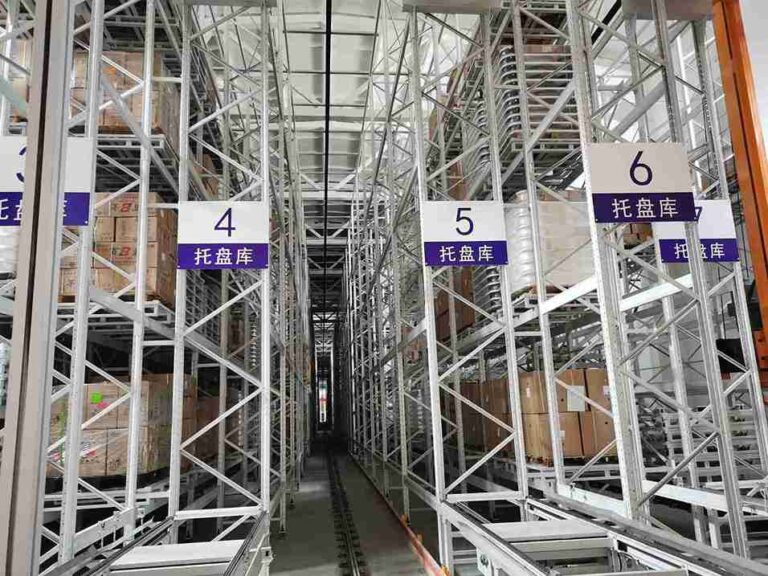📐"前 50 个企业查询可获得定制 3D 仓库设计" 计划

Introduction: The Rise of Automated Pallet Retrieval Systems (APRS)
The logistics industry is undergoing a radical transformation, and Automated Pallet Retrieval Systems (APRS) are at the forefront of this revolution. These cutting-edge systems eliminate manual handling, reduce labor costs, and maximize storage efficiency—making them indispensable for modern warehouses.
For businesses looking to stay competitive, understanding Automated Pallet Retrieval Systems (APRS) is no longer optional. This guide dives deep into how APRS works, their benefits, different types, and why they outperform traditional warehousing methods. Whether managing a small distribution center or a large-scale fulfillment hub, this comprehensive breakdown will help decision-makers evaluate if Automated Pallet Retrieval Systems (APRS) are the right investment.

H1: What Are Automated Pallet Retrieval Systems (APRS)?
Automated Pallet Retrieval Systems (APRS) are advanced robotic solutions designed to store, retrieve, and transport pallets with minimal human intervention. Unlike conventional forklift-based operations, APRS integrates automation, artificial intelligence, and high-density storage to optimize warehouse performance.
H2: How Automated Pallet Retrieval Systems (APRS) Work
At their core, Automated Pallet Retrieval Systems (APRS) rely on:
- Automated Storage and Retrieval Systems (AS/RS) – Robotic cranes that move pallets in high-bay racking.
- Autonomous Mobile Robots (AMRs) & AGVs – Self-navigating vehicles that transport pallets across the warehouse.
- AI-Powered Warehouse Management Software (WMS) – Optimizes inventory placement based on demand patterns.
- RFID & Barcode Scanning – Ensures 99.9%+ accuracy in tracking and retrieval.
By eliminating human error and reducing dependency on manual labor, Automated Pallet Retrieval Systems (APRS) deliver faster, more reliable operations.
H1: Types of Automated Pallet Retrieval Systems (APRS)
H2: 1. Unit-Load AS/RS (Automated Storage and Retrieval Systems)
Designed for heavy-duty pallet handling, Unit-Load AS/RS is ideal for industries like food & beverage, automotive, and pharmaceuticals. These Automated Pallet Retrieval Systems (APRS) can store pallets up to 50 feet high, maximizing vertical space.
H2: 2. Mini-Load AS/RS for Smaller Loads
Perfect for e-commerce and retail distribution, Mini-Load AS/RS handles lighter pallets or individual cases with precision. These Automated Pallet Retrieval Systems (APRS) are faster and more flexible than traditional forklift operations.
H2: 3. Shuttle-Based Automated Pallet Retrieval Systems
Using autonomous shuttles that move horizontally and vertically within racking, Shuttle-Based APRS provides ultra-fast retrieval for deep-lane storage. These systems are among the most efficient Automated Pallet Retrieval Systems (APRS) available today.
H2: 4. AGV & AMR-Driven Pallet Retrieval
Automated Guided Vehicles (AGVs) and Autonomous Mobile Robots (AMRs) are revolutionizing pallet movement. Unlike fixed systems, these Automated Pallet Retrieval Systems (APRS) can adapt to changing warehouse layouts dynamically.
H2: 5. Robotic Palletizing/Depalletizing Systems
Robotic arms integrated with Automated Pallet Retrieval Systems (APRS) can stack, unstack, and reposition pallets with unmatched speed. These systems are essential for high-volume manufacturing and distribution centers.
H1: Key Benefits of Automated Pallet Retrieval Systems (APRS)
H2: 1. Unmatched Storage Density
By utilizing vertical space, Automated Pallet Retrieval Systems (APRS) can store 4x more pallets than conventional racking.
H2: 2. Drastic Labor Cost Reduction
With Automated Pallet Retrieval Systems (APRS), warehouses can cut labor expenses by 30-50%, as fewer forklift operators are needed.
H2: 3. Lightning-Fast Order Fulfillment
APRS can retrieve 50+ pallets per hour, ensuring same-day or next-day shipping capabilities.
H2: 4. Near-Perfect Inventory Accuracy
Thanks to AI-driven tracking, Automated Pallet Retrieval Systems (APRS) reduce misplacements and stock discrepancies to almost zero.
H2: 5. Enhanced Workplace Safety
Fewer forklifts mean fewer accidents. Automated Pallet Retrieval Systems (APRS) create a safer, more ergonomic work environment.
H1: Who Needs Automated Pallet Retrieval Systems (APRS)?
H2: 1. High-Volume Distribution Centers
If a warehouse handles thousands of pallets daily, Automated Pallet Retrieval Systems (APRS) are a game-changer.
H2: 2. Cold Storage & Food Logistics
APRS minimizes human exposure in freezer warehouses, reducing energy loss and spoilage.
H2: 3. Pharmaceutical & Medical Supply Warehouses
Regulatory compliance demands precision—Automated Pallet Retrieval Systems (APRS) ensure perfect traceability.
H2: 4. E-Commerce & Retail Fulfillment
With consumers expecting same-day shipping, APRS provides the speed and accuracy needed to compete.
H1: Future Trends in Automated Pallet Retrieval Systems (APRS)
H2: 1. AI & Predictive Analytics
Future Automated Pallet Retrieval Systems (APRS) will use machine learning to anticipate stock movements before orders are placed.
H2: 2. Blockchain for Supply Chain Transparency
Integrating blockchain with APRS will create tamper-proof inventory records, crucial for high-compliance industries.
H2: 3. Green Warehousing & Energy Efficiency
Next-gen Automated Pallet Retrieval Systems (APRS) will focus on reducing carbon footprints through smart energy use.
H1: How to Choose the Right Automated Pallet Retrieval System (APRS)
H2: 1. Assess Warehouse Layout & Needs
- Measure ceiling height, floor space, and daily pallet movements.
H2: 2. Calculate ROI & Budget
- Automated Pallet Retrieval Systems (APRS) typically pay for themselves in 3-5 years.
H2: 3. Partner with an Industry-Leading Provider
- Look for vendors with proven expertise in APRS, such as Dematic, Honeywell, or SSI Schaefer.
H1: Conclusion – Why APRS Are the Future of Warehousing
Automated Pallet Retrieval Systems (APRS) are no longer a luxury—they’re a necessity for any warehouse aiming for peak efficiency, cost savings, and scalability. From AS/RS and AGVs to AI-driven optimization, these systems offer a competitive edge in today’s fast-moving logistics landscape.
For businesses ready to future-proof their operations, investing in Automated Pallet Retrieval Systems (APRS) is the smartest move.
H1: Frequently Asked Questions (FAQs)
H2: 1. How much do Automated Pallet Retrieval Systems (APRS) cost?
Prices range from 5M+, depending on scale and complexity.
H2: 2. Can APRS handle mixed pallet sizes?
Yes, advanced Automated Pallet Retrieval Systems (APRS) use adaptive grippers and AI vision to manage varying pallet dimensions.
H2: 3. What’s the ROI timeline for APRS?
Most businesses see a full return on investment in 3-5 years due to labor savings and efficiency gains.
H2: 4. Are Automated Pallet Retrieval Systems (APRS) compatible with existing WMS?
Leading APRS providers ensure seamless integration with SAP, Oracle, and other WMS platforms.
H2: 5. How long does APRS installation take?
Deployment typically takes 3-12 months, depending on warehouse size and system complexity.


